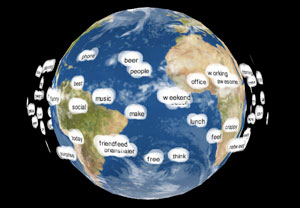Much of the technology industry’s history lies in Silicon Valley. Some other areas recognized for their technology communities include the Greater New York area, Los Angeles, Boston, Seattle, Raleigh-Durham, Pittsburgh, etc.
[Wired Magazine: 10 Top Tech Towns]
Phoenix rarely receives a second of thought when people list technology cities. Many people think or say “Nothing is going on in Phoenix.” The frightening part is hearing people in Phoenix say that.
Reasons why Phoenix has a weak tech community
The Phoenix metropolitan area is very spread out. It is difficult for people to get by without a car. It is difficult for those who have cars to go out and meet people. How many people do you meet in your car on your one hour commute each way to and from work? None.
It is difficult to meet and stay in touch (in person) with many people in Phoenix, so most people in Phoenix seem to have fewer close friends (compared to cities like San Francisco or New York City). You have to go out of your way to attend group meet-ups. Usually way out of your way. How many people are willing to drive an extra hour after a long work day to stay out late with other geeks, then drive another hour to get home? Not many.
The internet makes it easy for people to communicate, but it is difficult to communicate with people you don’t know exist.
Why it is getting better
I have only lived in Phoenix for a few years, so it is difficult to compare current trends with those in the past. However, in the last 1-2 years, I have noticed much change for the better in the tech community.
For those who don’t know, Phoenix is the 5th most-populated city in the United States[1] with 1,512,986 residents. The Phoenix metropolitan area is the 13th most-populated MSA in the United States[2] with 4,179,427 residents. The Phoenix metropolitan area contains a number of other highly-populated cities, such as Mesa (#38 most-populated city, with 447,541 residents), Glendale (#72, 246,531), Chandler (#76, 240,595), Scottsdale (#79, 231,127), Gilbert (#115, 191,517), Tempe (#134, 169,712), and Peoria (#168, 142,024).
My favorite statistic is regarding the Phoenix metropolitan area’s growth rate during the last 7 years: 28.52%. That is a much higher growth rates than most of the other large metropolitan areas in the country.
[1 – Wikipedia: List of United States cities by population]
[2 – Wikipedia: List of United States metropolitan areas]
How many Phoenix-based bloggers do you know? Most people would answer that with a very low number. As I mentioned above, many Phoenicians are unaware of all the things going on in Phoenix. ReadPhoenix.com, a site maintained by Erica Lucci, currently contains links to 136 Phoenix-based blogs. The number is growing and efforts like ReadPhoenix should help connect people within the Phoenix community.
Meeting attendance seems to be gradually growing at groups like Refresh/Refactor/Refocus Phoenix, Social Media Club, etc. The number of meet-ups taking place around the valley seems to be increasing as well. It is still difficult for people active in the community and willing to attend events to find out where and when they are. In an effort to connect with more people in the Phoenix area and share with them the events I find out about, I have been searching for and connecting with Twitter users who have Phoenix-area cities listed in their Twitter profiles.
There are also quite a few conferences being organized in the area. If you haven’t heard of these, check them out: PodCampAZ, BarCamp Phoenix, Desert Code Camp, AZ Entrepreneurship Conference, etc.
Right now, Phoenix has a large, but spread-out and loose, technology community. The goal needs to be connecting all the separate threads. It’s essentially a marketing problem. We need to reach and mobilize people who are probably willing to meet up, but have no good ways of hearing about local events.


